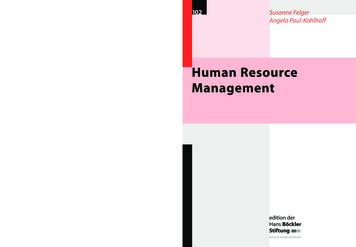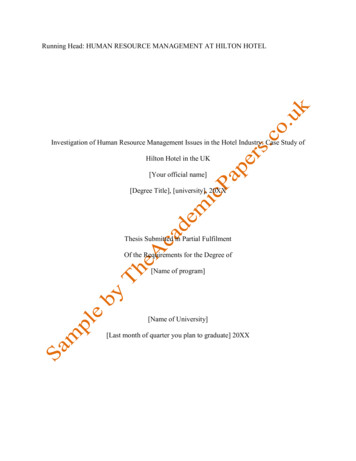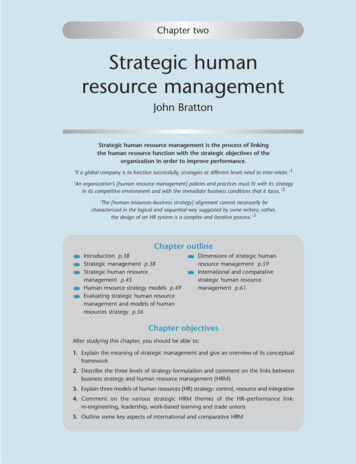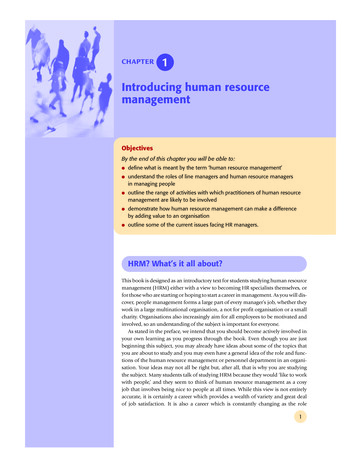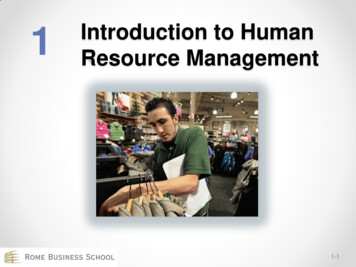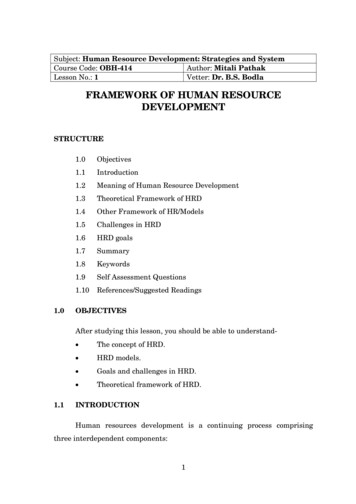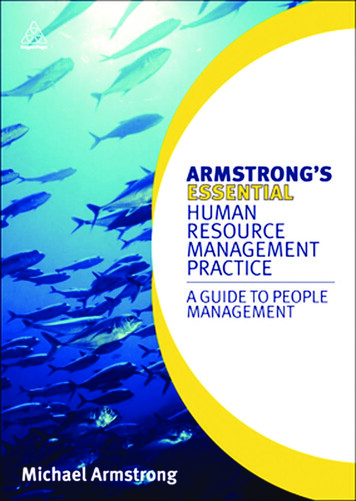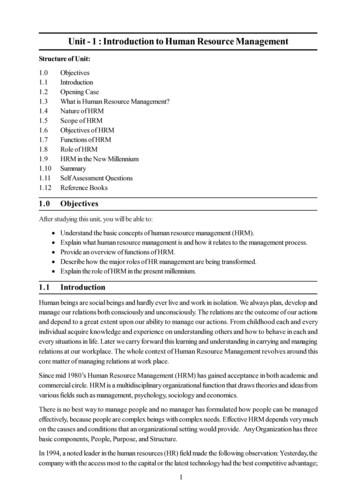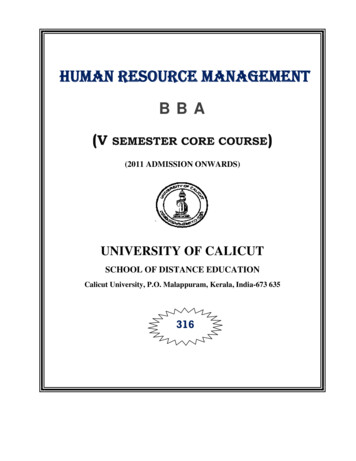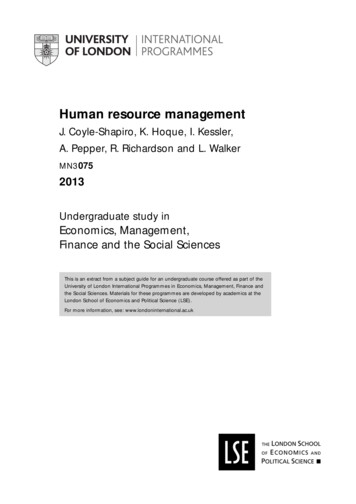
Transcription
Human resource managementJ. Coyle-Shapiro, K. Hoque, I. Kessler,A. Pepper, R. Richardson and L. WalkerMN30752013Undergraduate study inEconomics, Management,Finance and the Social SciencesThis is an extract from a subject guide for an undergraduate course offered as part of theUniversity of London International Programmes in Economics, Management, Finance andthe Social Sciences. Materials for these programmes are developed by academics at theLondon School of Economics and Political Science (LSE).For more information, see: www.londoninternational.ac.uk
This guide was prepared for the University of London International Programmes by:J. Coyle-Shapiro, PhD, Professor of Organisational Behaviour and Head of EmploymentRelations and Organisational Behaviour, LSE.K. Hoque, Bsc (Econ), PhD, Professor of Human Resource Management, Warwick BusinessSchool, Univeristy of Warwick.I. Kessler, BA, MA, PhD, Professor of International Human Resource Management, King’sCollege London.A. Pepper, DBA, Professor of Management Practice, LSE.R. Richardson, BSc, MA, PhD, Formerly Deputy Director, Reader in Industrial Relations, LSE.L. Walker, MA, Seear Fellow, LSE.This is one of a series of subject guides published by the University. We regret that dueto pressure of work the authors are unable to enter into any correspondence relating to,or arising from, the guide. If you have any comments on this subject guide, favourable orunfavourable, please use the form at the back of this guide.University of London International ProgrammesPublications OfficeStewart House32 Russell SquareLondon WC1B 5DNUnited Kingdomwww.londoninternational.ac.ukPublished by: University of London University of London 2013The University of London asserts copyright over all material in this subject guide except whereotherwise indicated. All rights reserved. No part of this work may be reproduced in any form,or by any means, without permission in writing from the publisher. We make every effort torespect copyright. If you think we have inadvertently used your copyright material, please letus know.
ContentsContentsIntroduction . 1Structure of the guide . 2Activities . 2Style of the guide . 2Aims . 2Learning outcomes . 2Syllabus. 3Using this subject guide . 3Essential reading . 4Further reading. 4Online study resources . 5How the reading is listed . 6Examination advice. 7Chapter 1: Human resource management: theories, models, policiesand practices . 111.1 Introduction . 111.2 What is HR management? . 121.3 Why are HR policies, programmes and plans so important?. 131.4 How do HR policies, programmes and plans work?. 161.5 The difference between academic study and the practice of HR management . 201.6 A reminder of your learning outcomes . 21Chapter 2: Recruitment and selection . 252.1 Introduction . 252.2 The importance of recruitment and selection . 262.3 Recruitment. 282.4 Selection . 362.5 Is there an ideal, or ‘one best way’ approach to final selection? . 412.6 A reminder of your learning outcomes . 432.7 Test your knowledge and understanding . 43Chapter 3: Training and development . 453.1 Introduction . 453.2 Definitions of training and development . 473.3 Why is training and development important? . 483.4 Considerations in the design of training programmes. What are the major stagesinvolved in designing a training programme? . 513.5 Implementing training . 523.6 Learning methods . 553.7 Barriers to learning . 563.8 Learning theories . 573.9 Vocational education . 583.10 A reminder of your learning outcomes . 593.11 Test your knowledge and understanding . 59i
MN3075 Human resource managementChapter 4: Individual performance: attitudes and behaviour . 634.1 Introduction . 634.2 What is performance? . 654.3 Conceptualisation of performance. 664.4 Task and contextual performance . 674.5 Organisational citizenship behaviour as contextual performance . 684.6 Consequences of OCB . 704.7 Antecedents of OCB . 724.8 Social exchange constructs . 724.9 Commitment . 744.10 Summary . 774.11 A reminder of your learning outcomes . 774.12 Test your knowledge and understanding . 784.13 Sample examination question . 78Chapter 5: Psychological contracts . 795.1 Introduction . 795.2 Definitions of psychological contracts . 825.3 Social exchange theory . 835.4 With whom does an employee have a contract? . 845.5 Categorising employer relationships with employees . 855.6 Types of contracts . 865.7 How are transactional and relational contracts related?. 885.8 Measurement of psychological contract. 895.9 The key features of the psychological contract . 915.10 Creation and management of the psychological contract . 915.11 Development of contract breach and violation . 935.12 Consequences of the psychological contract breach. 965.13 Human resource practices and psychological contracts . 985.14 Are psychological contracts changing? . 985.15 Summary . 1005.16 A reminder of your learning outcomes . 1015.17 Test your knowledge and understanding . 101Chapter 6: Reward systems and motivation . 1036.1 Introduction . 1036.2 Definitions and classifications . 1056.3 Selecting a pay scheme . 1086.4 Pay schemes in operation. 1126.5 Reward outcomes . 1146.6 Principal–agent theory . 1146.7 Motivation theory . 1156.8 Process theories – how are people motivated? . 1176.9 Pay, attitudes and behaviours. 1186.10 A reminder of your learning outcomes . 1216.11 Test your knowledge and understanding . 1216.12 Sample examination question . 121Chapter 7: Performance management. 1237.1 Introduction . 1237.2 Definitions and classifications . 1257.3 Selecting an approach . 1267.4 Design features . 130ii
Contents7.5 A reminder of your learning outcomes . 1377.6 Test your knowledge and understanding . 1377.7 Sample examination question . 137Chapter 8: Job design and redesign . 1398.1 Introduction . 1398.2 Taylorism and scientific management . 1418.3 Job enlargement . 1428.4 Herzberg and job enrichment . 1438.5 Hackman and Oldham’s job characteristics model. 1448.6 Teamworking . 1488.7 Management teams. 1548.8 A reminder of your learning outcomes . 1578.9 Test your knowledge and understanding . 157Chapter 9: Employee involvement and participation. 1619.1 Introduction . 1619.2 Definitions and classifications . 1639.3 Approaches to employee involvement and participation. 1709.4 Employee participation: objectives and patterns at the micro and macro levels . 1719.5 Changing patterns of employee involvement and participation . 1729.6 Employee involvement and participation in practice . 1749.7 Impact and outcomes . 1779.8 A reminder of your learning outcomes . 1799.9 Test your knowledge and understanding . 180Chapter 10: Organisational justice . 18110.1 Introduction . 18110.2 Different conceptualisations of justice . 18310.3 Procedural justice . 18610.4 Why does procedural justice matter? . 18810.5 Outcomes of justice . 18910.6 Procedural justice applied to motivation . 19110.7 Organisational justice and HR practices . 19210.8 Organisational justice and performance appraisal . 19410.9 Summary . 19510.10 A reminder of your learning outcomes . 19510.11 Test your knowledge and understanding . 19610.12 Sample examination question . 196Chapter 11: Diversity and equal opportunities . 19711.1 Introduction . 19711.2 What is the current position of women in the labour market? . 20011.3 How can we explain the disadvantaged position faced by women?. 20311.4 Equal opportunities policies . 20611.5 The business argument for equal treatment . 20811.6 The role of the government in promoting equality of opportunity . 21211.7 The role of trade unions . 21411.8 Self-employment . 21511.9 A reminder of your learning outcomes . 21511.10 Test your knowledge and understanding . 215Chapter 12: Labour economics . 21912.1 Introduction . 21912.2 The standard economic theory explaining the firm’s demand for labour . 220iii
MN3075 Human resource management12.3 Refinements to the standard theory . 22212.4 Internal labour markets. 22712.5 The HR implications of ILMs . 23012.6 Summary . 23112.7 A reminder of your learning outcomes . 23112.8 Test your knowledge and understanding . 23112.9 Sample examination question . 232Chapter 13: HR strategies and high performance work systems . 23313.1 Introduction . 23313.2 Human resource strategies. 23413.3 What is an HR strategy?. 23513.4 Is there one best HR strategy? . 23713.5 High performance work practices or high commitment practices . 23713.6 Possible contingencies . 23913.7 Comment . 24113.8 The changing context of HR decisions. 24113.9 The growing importance of HR strategies . 24313.10 Greater HR flexibility and the implication for HR strategy . 24813.11 A reminder of your learning outcomes . 25013.12 Test your knowledge and understanding . 25013.13 Sample examination question . 250Chapter 14: Studying HR management . 253Appendix 1: Full list of further reading for the course . 255Books. 255Journal articles . 256Appendix 2: Sample examination paper . 259Appendix 3: Guidelines for answering sample examination questions . 261Chapter 4 . 261Chapter 6 . 261Chapter 7 . 262Chapter 10 . 262Chapter 12 . 263Chapter 13 . 264iv
IntroductionIntroductionThis subject guide is about human resource management (HRM). This is themanagement activity taken by commercial firms, state owned enterprisesand other organisations to recruit, retain and motivate their employees. Inother words HRM is the bundle of policies, programmes and plans whichorganisations adopt with the objective of making full use of the people theyemploy. These include everything from recruitment and selection techniques(which initiate the relationship between firm and employee), to the mass ofrules that determine how people are treated as current employees, and allthe way to policies on separation (which determine whether, and in whatcircumstances, an employee is to be let go).This guide takes, as its organising framework, a model of strategicHRM advanced by Boxall and Purcell in their book Strategy and humanresource management (Palgrave Macmillan, third edition, 2011). Theyconceptualise workforce performance as a function of capabilities (theknowledge, skills and aptitudes which employees need to carry out theirwork), motivation (the incentives which employees require to encouragethem to perform to the best of their abilities) and work organisation(the way that work and organisations are structured so as to allowemployees to perform well). To this we add employment relations (thepolicies, programmes and practices which govern the relationship betweenemployees and employers) on the basis that employee relationshipmanagement is a key responsibility of the HRM function. See Figure 1.The guide follows the perspective adopted in most HRM textbooks andlooks at the subject from an organisational point of view, but it alsoacknowledges that a range of other factors shape the use of HRM policiesand practices, including government and regulatory onWork organisationFigure 1: Organising framework1
MN3075 Human resource managementStructure of the guideThe guide is divided into 14 chapters, each focusing on a different topic.Every chapter includes a number of features: the Learning outcomes for the chapter the Essential and Further reading lists a list of References cited in the chapter an Introduction to the topic of the chapter a chapter Summary or Conclusion section at the end of each chapter a range of Sample examination questions to help you to test what youhave learnt. (See Appendix 3 for feedback).ActivitiesIn addition to these key features of every chapter, Activities have beenprovided throughout the guide to help you engage and interact with thematerial you are studying. Although these are not assessed, it is stronglyrecommended that you complete these Activities as you work throughthe course. Taking an active role from the beginning of this course anddeveloping this throughout, will give you confidence in your knowledge,ability and opinions.Style of the guideThe study of HRM is multidisciplinary drawing upon ideas from businessstrategy, economics, psychology, sociology and industrial relations. Whatthis means is that you will receive a range of viewpoints on the subjectas a whole. You may also notice a difference in approach from chapter tochapter.AimsThe aims of this course are to: give students an introduction to the key elements of human resourcemanagement demonstrate how the social sciences can assist in understanding themanagement of human resources; and to examine and evaluate humanresource policies and practices of organisations help students to examine the different theories which try to explain therelationship between HRM and organisational performance develop students’ ability to analyse and critically evaluate HR policiesand practices.Learning outcomesBy the end of this course, and having completed the Essential reading andActivities, you should be able to: describe the relationship between HRM and organisationalperformance and be able to critically evaluate the empirical evidence critically evaluate alternative perspectives on HR practices analyse the relationship between HR practices and their outcomes forthe individual and the organisation2
Introduction evaluate the effectiveness of different HR practices comment upon the limitations of the theories covered.SyllabusThe syllabus uses as its organising framework a model of HRM builtaround four areas of activity: capabilities, motivation, employmentrelations and work organisation.‘Capabilities’ include recruitment and selection, as well as learningand development. ‘Motivation’ covers individual performance and thepsychological contract, reward systems, performance managementand job design. ‘Employment relations’ include employee involvementand participation, organisational justice and diversity. Finally, ‘workorganisation’ covers labour markets, high performance work systems andthe state of HRM in contemporary organisations.The syllabus examines current theoretical perspectives on the relationshipbetween human resource practices and organisational performance.These include strategic HRM, organisational behaviour and employmentrelations frameworks, which offer different explanations of how HRMpractices impact on organisational performance. The relationship betweenmotivation, organisational commitment (defined as an individual’semotional attachment to an organisation) and both individual andcorporate performance is central to understanding the effects of HRMpractices on employees.The skills demonstrated by students are expected to go beyond knowledgeand comprehension. As well as demonstrating that they know andunderstand the major HRM policies and practices, theoretical frameworksand supporting empirical evidence, students are expected to be able toexplain the relationship between different human resource policies andpractices and the underlying theoretical frameworks (for example, bydescribing the relationship between performance management and goalsetting theory, or pay strategy and different theories of motivation). Thesetheoretical frameworks will then provide the basis for analysing andevaluating whether HRM practices are more or less likely to achieve theirhypothesized outcomes. The potential limitations of each theory and thesubsequent implications for organisational practice will also be considered.Using this subject guideThis subject guide presents a basic introduction to the main topics in thestudy of human resource management. As with any guidebook, this subjectguide is designed to help you find your way around the subject matter. Itseeks to outline, explain and clarify the central concerns of the study aswell as provide information about studying for your examinations.On the other hand, because it is a guide, it cannot go into detail and thereare bound to be omissions and over simplifications. Wider reading is,therefore, essential. You should not just treat this subject guide as yourtextbook. If you place too much emphasis on the subject guide withoutdoing additional reading, you will find it exceedingly difficult to pass theexamination.You should also develop your own set of notes as you work through thesubjects, which will help you engage with the material in a critical way.3
MN3075 Human resource managementEssential readingYour Essential reading for this course comes from three places: textbooks,journal articles and one chapter of a textbook available in the virtuallearning environment (VLE).TextbooksThree textbooks are recommended for this course. These are generaltextbooks that are useful for most chapters in this guide. You should buy,or have regular access to, these textbooks as a number of the Essentialreading are taken from them. Please remember that the more you read,the better your understanding of the subject area will be.Bratton, J. and J. Gold Human resource management: theory and practice.(Basingstoke: Palgrave, 2012) fifth edition [ISBN 9780230580565].Kramar, R. and J. Syed Human resource management in a global context.(Basingstoke: Palgrave,
Introduction 1 Introduction This subject guide is about human resource management (HRM). This is the management activity taken by commercial firms, state owned enterprises and other organisations to recruit, retain and motivate their employees. In other words


